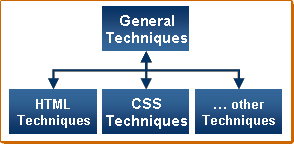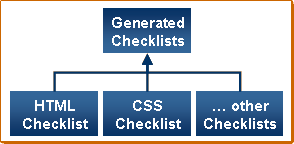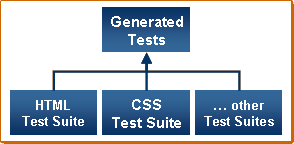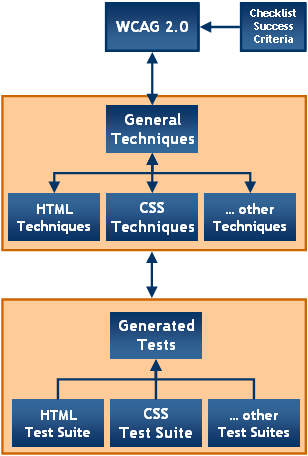Introduction
This page introduces WCAG 2.0 Working Draft documents as of November 2004. For general information about Web Content Accessibility Guidelines (WCAG) and WCAG 1.0, see Web Content Accessibility Guidelines (WCAG) Overview.
Web Content Accessibility Guidelines 1.0 was approved in May 1999 and is the stable and referenceable version.
WCAG 2.0 is being developed to apply to different Web technologies and to be easier to use and understand, as documented in Requirements for WCAG 2.0. WAI anticipates WCAG 2.0 may be completed in the first half of 2005. Because of the nature of the W3C specification development process, WAI cannot be certain when the final version of WCAG 2.0 will be available. Therefore, WCAG 1.0 will remain the latest approved version at least through the beginning of 2005.
WCAG 2.0 Working Draft Documents
WCAG 2.0
The main WCAG 2.0 document applies to all Web content; it is not specific to any one technology.
WCAG 2.0 is organized around four design principles for Web accessibility:
- Content must be perceivable
- Interface elements in the content must be operable
- Content and controls must be understandable
- Content must be robust enough to work with current and future Web technologies
Under each principle are guidelines that define how the principle applies in a specific area.
Under each guideline are success criteria, definitions, benefits, and examples. Success criteria are testable statements to further define the guideline and to determine conformance.
Techniques

General Techniques for WCAG 2.0 applies to all Web content; it is not specific to any one technology. The General Techniques document provides implementation guidance, explanations, and strategies.
Each technology-specific techniques document provides implementation guidance, preferred approaches, and markup examples for a specific Web technology.
- HTML Techniques for WCAG 2.0
- CSS Techniques for WCAG 2.0
- Client-side Scripting Techniques for WCAG 2.0
- (Additional technology-specific techniques will be available with future Working Drafts, such as Sever-Side Scripting, SMIL, and SVG Techniques.)
The techniques documents are organized by topic; for example, HTML Techniques includes sections on forms, images, lists, links, tables, etc.
Checklists

The checklists are lists of testable statements that define what is required to meet WCAG 2.0 in a specific Web technology.
-
(HTML, CSS, and other Checklists will be available with future Working Drafts)
Customized checklists can be generated based on selected Web technologies, elements, and other criteria.
Test Suites

Test suites provide sample files that can be used for testing accessibility implementations for a specific Web technology.
-
(HTML, CSS, and other Test Suites will be available with future Working Drafts)
Customized test suites are generated based on selected Web technologies, elements, and other criteria.
Navigating WCAG 2.0 Documents
Throughout the documents are links to related information in other documents. Navigation between documents may change in future designs of WCAG 2.0.
How WCAG 2.0 Working Drafts Differ from WCAG 1.0
WCAG 1.0 Priority Checkpoints
WCAG 1.0 is organized around guidelines that have checkpoints, which are priority 1, 2, or 3. The basis for determining conformance to the WCAG 1.0 are the checkpoints.
WCAG 2.0 Level Success Criteria
The current WCAG 2.0 Working Draft is organized around four design principles of Web accessibility. Each principle has guidelines, and each guideline has success criteria at level 1, 2, or 3. The basis for determining conformance to the WCAG 2.0 Working Draft are the success criteria.
Differences in Related Documents
There are also some differences in the WCAG 1.0 and WCAG 2.0 related documents:
- Techniques documents
- WCAG 1.0:
- The Techniques for WCAG 1.0 document, sometimes called the "Techniques Gateway", provides only links to relevant technology-specific techniques documents, as explained in Navigating WCAG 1.0 Guidelines and Techniques Documents. A separate document, Core Techniques for WCAG 1.0, provides general techniques.
- Has two technology-specific techniques documents, covering HTML and CSS.
- WCAG 2.0:
- General Techniques for WCAG 2.0 provides both general techniques and links to technology-specific techniques documents.
- There will be several techniques documents for WCAG 2.0, including HTML, CSS, scripting, and others. The technology-specific techniques documents for WCAG 2.0 are much more robust and complete. They also link to evaluation information in the WCAG 2.0 checklists.
- WCAG 1.0:
- Checklists
- WCAG 1.0: Checklist of Checkpoints for Web Content Accessibility Guidelines 1.0 is a list of the WCAG 1.0 checkpoints, formatted in tables grouped by priorities.
- WCAG 2.0: The technology-specific checklists planned for WCAG 2.0 are lists of testable statements that define what is required to meet WCAG 2.0 in a specific technology. They provide additional information, beyond what is in WCAG 2.0 itself.
Mapping Between WCAG 1.0 and the WCAG 2.0 Working Draft is a draft document that shows the relationship between WCAG 1.0 checkpoints and WCAG 2.0 Working Draft guidelines.
WAI will provide additional resources to help organizations that are currently using WCAG 1.0 transition to WCAG 2.0.
 Getting Started
Getting Started Guidelines &
Techniques
Guidelines &
Techniques Checklist
Checklist
 WCAG 2.0 WD Intro
WCAG 2.0 WD Intro